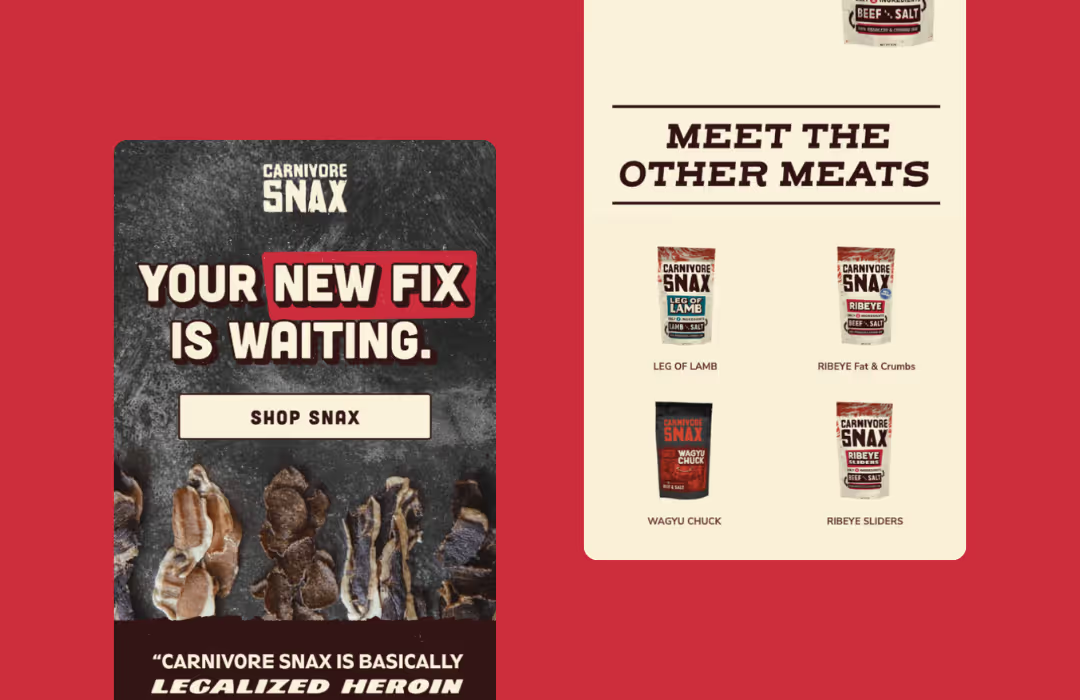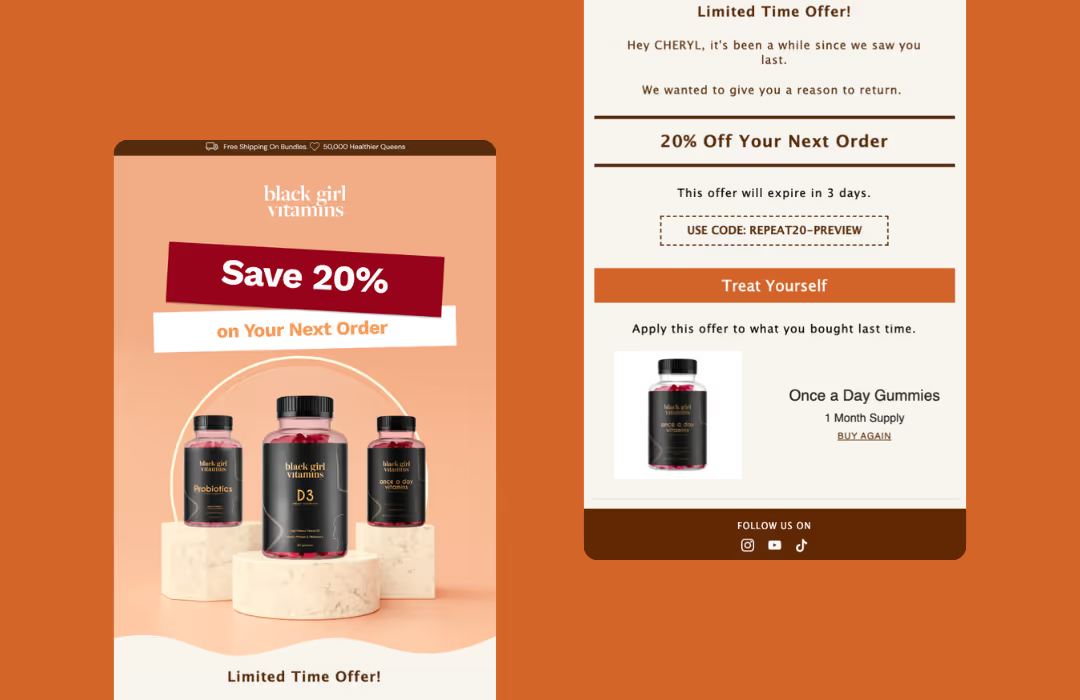The Stamped blog
12 Metrics to Help Brands Turn BFCM Data Into Action
Sure, hitting revenue targets is great. But BFCM is really about acquiring customers who'll stick around long after the holiday rush ends.
BFCM
Customer Insights
by Aiden Brady

Introduction
Black Friday Cyber Monday drives massive traffic and revenue spikes that make every merchant’s heart race. Sure, hitting revenue targets is great. But BFCM is really about acquiring customers who’ll stick around long after the holiday rush ends.
Here’s the problem, though: most merchants let their most valuable BFCM data collect dust while they’re busy fulfilling orders and managing the chaos.
The truth is, the insights hidden in your reviews and lifecycle marketing during this critical period are goldmines for building a retention strategy that works year-round. Let’s break down exactly which metrics deserve your attention and how to turn them into actionable strategies.
Why BFCM Data Matters for Retention
BFCM brings a unique mix of customers to your store: loyal repeat buyers, first-time purchasers lured by deals, and gift-givers who may never interact with your brand again. Understanding who’s who—and what they think about their experience—is essential for turning one-time holiday shoppers into lifetime customers.
Your reviews and lifecycle marketing data tell you what’s working, what’s not, and where your biggest opportunities lie. Let’s dig into the specific metrics that matter most.
Review Metrics to Track After BFCM
1. Review Volume and Velocity
What to measure: Total number of reviews submitted during and after BFCM, plus how quickly customers are leaving reviews post-purchase.
Why it matters: A spike in review volume indicates strong engagement, while slow review velocity might signal a disconnect in your post-purchase experience. If customers aren’t motivated to share their thoughts, they’re probably not motivated to come back either.
Action item: Compare your BFCM review velocity to your baseline (calculate this by taking the average number of reviews collected per week over the past 12 months, or use a specific seasonal period that reflects typical buying behavior). If it’s lower, consider ramping up your review request campaigns or adjusting the timing of your outreach.
2. Star Rating Distribution
What to measure: The breakdown of 1-5 star ratings, with particular attention to the ratio of 4-5 star reviews versus 1-3 star reviews.
Why it matters: Your overall rating influences conversion, but the distribution tells the real story. A concentration of 1-2 star reviews about specific products or issues reveals urgent problems that could derail retention efforts.
Action item: Identify patterns in lower-rated reviews. Are complaints centered on shipping delays, product quality, or unmet expectations from marketing? Address these systematically before launching retention campaigns.
Use post-review segmentation to automate personalized responses based on star ratings, and make sure you’re replying to critical reviews directly on-site so future customers can see how you handle criticism and turn negative experiences around.
3. Product-Level Review Performance

What to measure: Which specific products received the most reviews and the highest ratings during BFCM.
Why it matters: Your best-reviewed BFCM products are your retention anchors. These are the items that delighted customers and have the highest potential for driving repeat purchases and positive word-of-mouth.
Action item: Build your post-BFCM marketing around your highest-rated products. Feature them in win-back campaigns, upsell sequences, and loyalty program rewards.
4. Review Sentiment and Keywords
What to measure: Common themes, phrases, and pain points mentioned in review text, especially around shipping, packaging, product quality, and value perception.
Why it matters: Quantitative ratings only tell half the story. The qualitative insights in review text reveal what customers actually care about and what drove their satisfaction (or frustration).
Additionally, calculating the number of reviews that include specific, detailed keywords is an indicator of review quality—reviews with substantive feedback are far more valuable than generic “Loved it!” or “Shipping was fast” comments.
Action item: Use sentiment analysis to identify your biggest wins and your most critical gaps. If customers rave about your packaging, lean into that in your branding. If they complain about sizing, update your product pages and consider a size-guide content series.
5. Photo and Video Review Rate

What to measure: Percentage of reviews that include customer-generated photos or videos.
Why it matters: Visual reviews are social proof on steroids. They build trust, increase conversion rates, and signal high customer engagement. Plus, they’re invaluable content for your marketing channels.
Action item: Incentivize visual reviews in your post-BFCM follow-up campaigns. Offer bonus loyalty points or entries into a giveaway for customers who share photos or videos.
6. First-Time Buyer Review Rate
What to measure: The percentage of BFCM first-time customers who left reviews compared to repeat customers.
Why it matters: First-time buyers who take the time to review are more likely to become repeat customers. A low review rate among new customers suggests they’re not engaged enough with your brand to invest time in sharing feedback.
Action item: Create a targeted review request campaign specifically for BFCM first-time buyers. Make it easy, personal, and incentivized.
Lifecycle Metrics to Track After BFCM
7. Email Engagement Rate by Customer Segment
What to measure: Open rates, click-through rates, and conversion rates broken down by customer type (first-time BFCM buyers, repeat customers, VIPs).
Why it matters: Not all BFCM customers are created equal. Understanding how different segments engage with your emails helps you tailor messaging and identify which groups need more nurturing.
Action item: Create separate email flows for first-time versus repeat BFCM customers. First-timers need brand education and trust-building, while repeat customers respond better to exclusive offers and new product launches.
8. Post-Purchase Email Performance
What to measure: Engagement and conversion rates for order confirmation, shipping updates, delivery confirmation, and review request emails sent during and after BFCM.
Why it matters: Post-purchase emails have some of the highest open rates of any email type. They’re prime real estate for cross-selling, gathering reviews, and building brand affinity when customers are most engaged.
Action item: Optimize your post-purchase email sequence to include strategic cross-sells, review requests, and brand story elements. Don’t waste these high-engagement touchpoints on purely transactional content.
9. Win-Back Campaign Response Rate

What to measure: How many BFCM customers who haven’t returned within 30-60 days respond to win-back emails, and what offers or messaging drives action.
Why it matters: Some BFCM customers will naturally come back, but many need a nudge. Your win-back performance tells you how effective your retention messaging is and which incentives work best.
Action item: Test different win-back approaches: discount-based, product recommendation-based, content-driven, or urgency-focused. Track which approach yields the highest re-engagement for your BFCM cohort.
10. Repeat Purchase Rate (Post-BFCM Window)
What to measure: The percentage of BFCM customers who make a second purchase within 30, 60, and 90 days post-BFCM.
Why it matters: This is your north star retention metric. It tells you whether your BFCM acquisition efforts are translating into long-term customer value.
Action item: Segment customers by repeat purchase behavior and create tailored win-back campaigns for those who haven’t returned. For those who have, deepen the relationship with VIP perks or early access to new products.
If you offer subscriptions, pay special attention to customers making multiple purchases of the same product—they’re prime candidates for subscription conversion, which can dramatically increase customer lifetime value.
11. Engagement with Loyalty Campaigns

What to measure: Open rates, click-through rates, and conversion rates for loyalty-specific (VIP programs, referral campaigns, exclusive member offers, etc.) email and SMS campaigns during the post-BFCM period.
Why it matters: Engagement metrics reveal how interested your customers are in ongoing communication with your brand. Low engagement suggests your messaging isn’t resonating or your offers aren’t compelling.
Action item: A/B test different messaging approaches, reward structures, and send times. Double down on what works and cut what doesn’t.
12. Churn Rate Among BFCM Customers
What to measure: The percentage of BFCM customers who disengage (don’t open emails, don’t make repeat purchases, unsubscribe) within the first 90 days.
Why it matters: High churn among BFCM customers indicates that your acquisition strategy attracted the wrong audience or that your post-purchase experience isn’t meeting expectations.
Action item: Identify common characteristics among churned customers (product purchased, discount received, etc.) and refine your targeting and onboarding for future campaigns.
Turning Insights Into a Winning Retention Strategy
Now that you know which metrics to track, here’s how to turn them into action:
Create a post-BFCM customer segmentation plan. Use your reviews and loyalty data to segment customers into groups: highly engaged, moderately engaged, and at-risk. Tailor your retention efforts to each segment with personalized messaging and offers.
Launch a strategic review generation campaign. Your best customers are your best marketers. Use insights from high-rated products to encourage more reviews and user-generated content that you can leverage throughout the year.
Optimize your email and SMS flows based on behavior data. If certain messages or offers drove higher engagement or conversion, make them more prominent. If customers aren’t responding, test new approaches and creative strategies.
Address product and service gaps immediately. Don’t let negative reviews or low satisfaction scores linger. Fix the issues, communicate the improvements to affected customers, and turn detractors into advocates.
Build a year-round calendar around your winners. Your top-performing BFCM products and campaigns should inform your entire 2026 strategy. Lean into what worked and iterate on what didn’t.
How Stamped Helps You Build a Post-BFCM Retention Strategy That Lasts
At Stamped, we understand that reviews, loyalty, and lifecycle marketing are the foundation of sustainable growth. Our platform gives you everything you need to collect, analyze, and act on customer data that drives retention.
With Stamped, you can:
- Automate review collection to capture feedback from every BFCM customer without lifting a finger
- Analyze sentiment and trends with powerful reporting tools that surface actionable insights
- Build and optimize a loyalty program that turns one-time buyers into repeat customers
- Leverage user-generated content to build trust and increase conversions year-round
- Segment and personalize your retention campaigns based on real customer behavior
The brands who win in 2026 will be the ones who successfully converted their BFCM customers into loyal, lifelong advocates.Ready to turn your BFCM data into a retention strategy that drives real results? Book a demo with Stamped and let’s build a plan that keeps your customers coming back all year long.
Related Articles

8 Last-Minute BFCM Fixes: What You Might’ve Missed
With Black Friday Cyber Monday just weeks away, most brands have their promotional strategies locked, ad budgets are set, and creative assets are finalized. But there's a critical gap many merchants overlook: the retention infrastructure that determines whether your BFCM traffic becomes expensive one-time buyers or valuable long-term customers.
by Aiden Brady
BFCM
Customer Insights
Retention Marketing Strategies

Stamped Loyalty 2.0: What’s New in Analytics
Discover Stamped Loyalty 2.0 with a new Analytics dashboard to track ROI, boost retention, and optimize your loyalty program for growth.
by Sammi Wong
Customer Insights
Loyalty

4 Emails That Get BFCM Buyers to Order Again
The brands that scale into 7 and 8 figures are the ones that know how to take that once-a-year flood of bargain hunters and transform them into year-round, loyal customers. The secret weapon? Strategic email flows designed specifically for post-BFCM lifecycle marketing.
by Aiden Brady
BFCM
Retention Marketing Strategies

